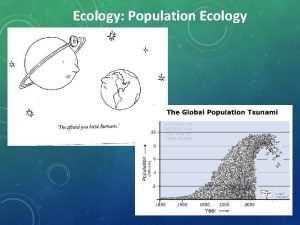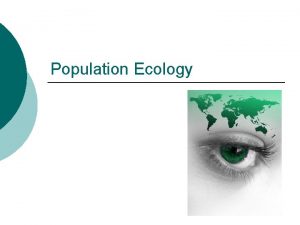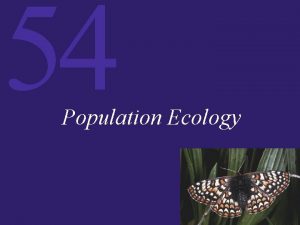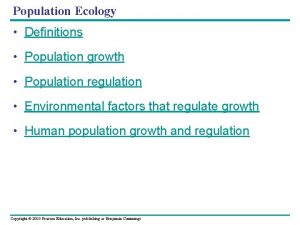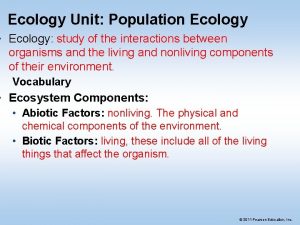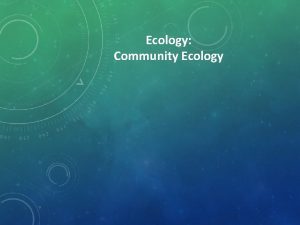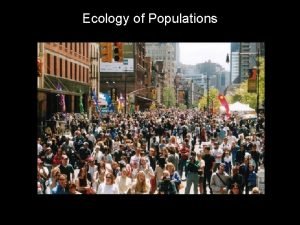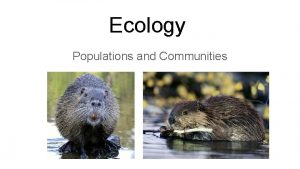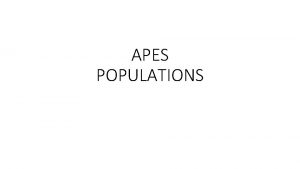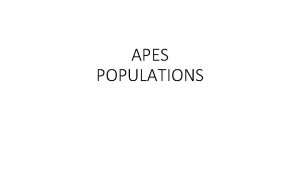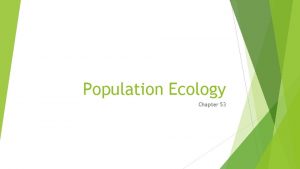UNIT 4 ECOLOGY Chapter 52 Populations POPULATION GROWTH

















- Slides: 17

UNIT 4: ECOLOGY Chapter 52: Populations

POPULATION GROWTH • Population: A group of individuals of the same species that live in the same area. • Population Growth: Increase in a population. • Population Growth Rate: The change in the number of individuals in a population over time. change in number of individuals Population Growth Rate = ----------------------time

POPULATION GROWTH • A population may grow at such a great rate that available resources become insufficient to support all its members. • Darwin’s theory was that when natural resources were limited, the fittest members of a given population would survive and the least fit would perish.

POPULATION GROWTH • Biotic Potential: The rate at which a population will grow if all individuals survive and reproduce at maximum capacity. • Biotic potential can be reached when organisms capable of reproducing are put into an ideal environment.

POPULATION GROWTH • In nature populations rarely achieve their biotic potential for any sustained period. • Eventually the number of individuals declines because of shortage of food, shortage of space, predation, or accumulation of waste. • Once a balance is reached between the number of individuals and the amount of resources available, the population becomes stable.

POPULATION GROWTH • Growth Curve: A graph showing the number of individuals in a population over time. • J-Shaped Curve: A growth curve that tracks two phases of population growth – the lag phase and the exponential phase.

POPULATION GROWTH • Lag Phase: Little or no increase occurs in a population. • Exponential Phase: A population increases so rapidly that the number of individuals doubles in a specific time interval and keeps doubling in increasingly shorter periods of time.

POPULATION GROWTH • S-Shaped Curve: A growth curve that depicts the period of relative stability in a population that occurs after its lag and exponential phases. • Carrying Capacity: The maximum number of individuals that the ecosystem is capable of supporting.

POPULATION GROWTH • When the environment is stable, the maximum number of individuals in a population fluctuates near the carrying capacity of the environment. • If the environment becomes unstable, the fluctuations become more radical.

POPULATION GROWTH • Population Density: The number of individuals in a population in a given area at a given time. • Density-Dependent Factors: Factors that affect populations in different ways depending on population density. • Food • Availability of Space • Availability of Light • Parasitic Infections • Disease • Predator/Prey Population • Availability of Oxygen

POPULATION GROWTH • Density-Independent Factors: Factors that affect populations regardless of population density. Usually abiotic. • Changes in Weather • Changes in Temperature • Changes in Humidity • Variations in Sunlight • Amount of Available Energy

HUMAN POPULATIONS • Domesticated: Plants and animals that are adapted or trained to live in a human environment. • By domesticating plants and animals people were often able to increase their food supply, even to create surpluses that could be stored.

HUMAN POPULATIONS • From about 6, 000 B. C. until about 1800, the number of people in the world increased steadily. This increase was relatively slow. Then in the middle of the eighteenth century the population began to increase dramatically. • This exponential growth rate can be largely explained by the increase in food production, the rise of industry, and advances in medicine.

HUMAN POPULATIONS

HUMAN POPULATIONS • To make predictions about population growth, population biologists must consider the composition of a population. • Consider the following example:

HUMAN POPULATIONS • Suppose that you want to predict the growth patterns for three small villages, all with the same number of people. One is made up of families with children, parents, and grandparents – a population of mixed age and sex. The second is made up solely of children. The third is made up only of elderly people. If you considered only external limits to growth, such as the availability of food and the potential for natural disasters, you would conclude that each of the three populations had the same potential for growth.

HUMAN POPULATIONS • The actual growth patterns for the three villages would differ dramatically. If no density-dependent or density-independent factors limited population growth, you could reasonably make the following assumptions: • The first population, a balanced one, could be expected to grow steadily. • The second population, consisting of members still too young to reproduce, would not grow at all for a time. Then, once the children reached reproductive maturity, the population would increase rapidly. • The third population, which consists entirely of members past their reproductive age, would decline until it reached zero.
 Chapter 4 section 1 population dynamics
Chapter 4 section 1 population dynamics Study guide section 1 population dynamics
Study guide section 1 population dynamics Population ecology section 1 population dynamics answer key
Population ecology section 1 population dynamics answer key Population ecology section 1 population dynamics
Population ecology section 1 population dynamics Logistic growth ecology definition
Logistic growth ecology definition Chapter 53 population ecology
Chapter 53 population ecology Equilibrial life history
Equilibrial life history Chapter 4 population ecology answer key
Chapter 4 population ecology answer key Chapter 53 population ecology
Chapter 53 population ecology Chapter 4 section 1 population dynamics
Chapter 4 section 1 population dynamics Chapter 53 population ecology
Chapter 53 population ecology Clumped dispersion
Clumped dispersion Population vs community ecology
Population vs community ecology Population vs community ecology
Population vs community ecology Concept 3 population ecology
Concept 3 population ecology Survivorship curve def
Survivorship curve def Population characteristic
Population characteristic Population characteristics ecology
Population characteristics ecology




















